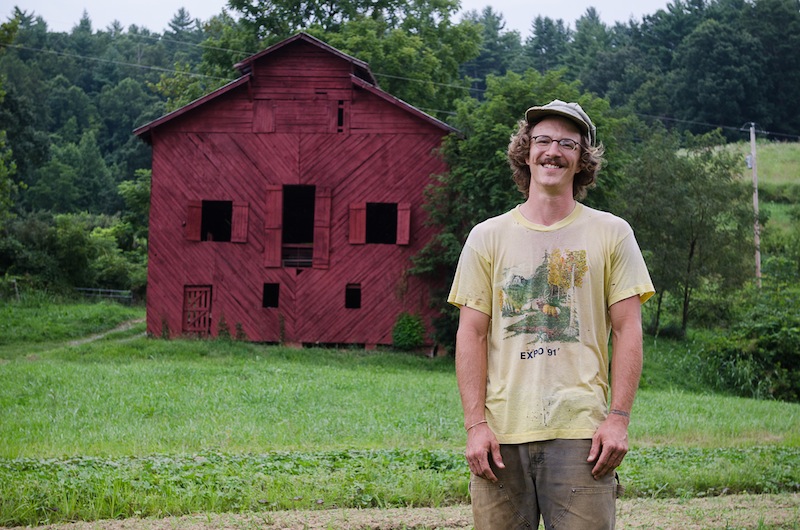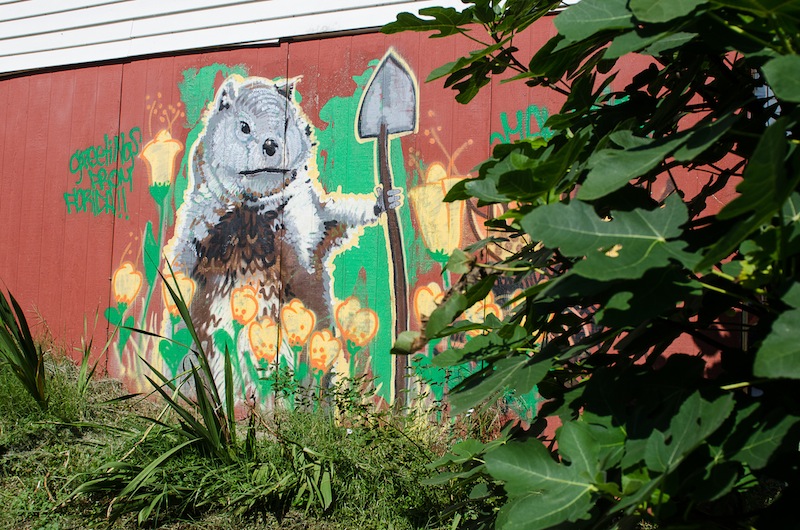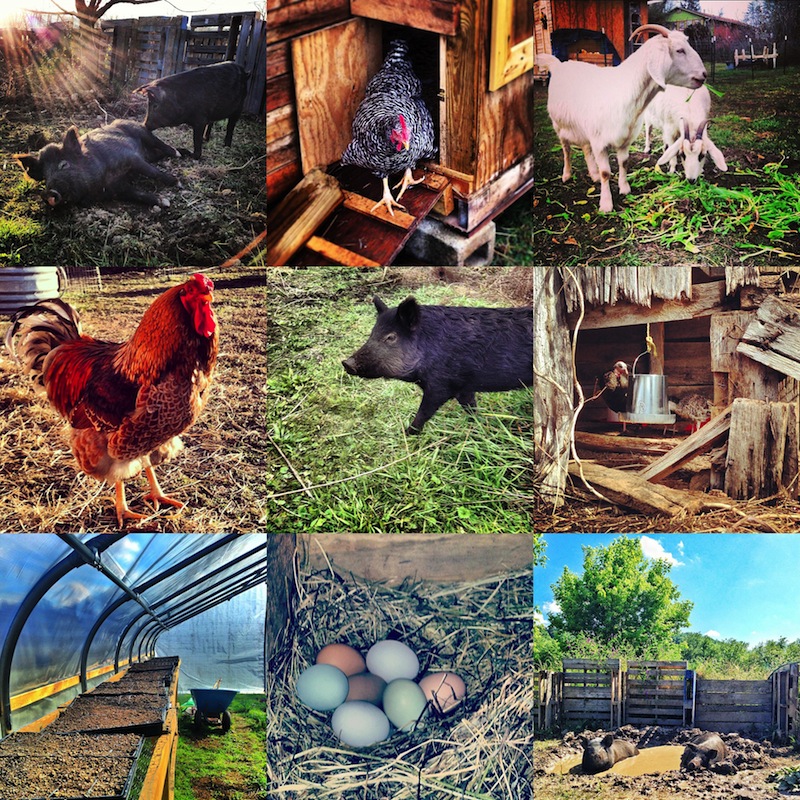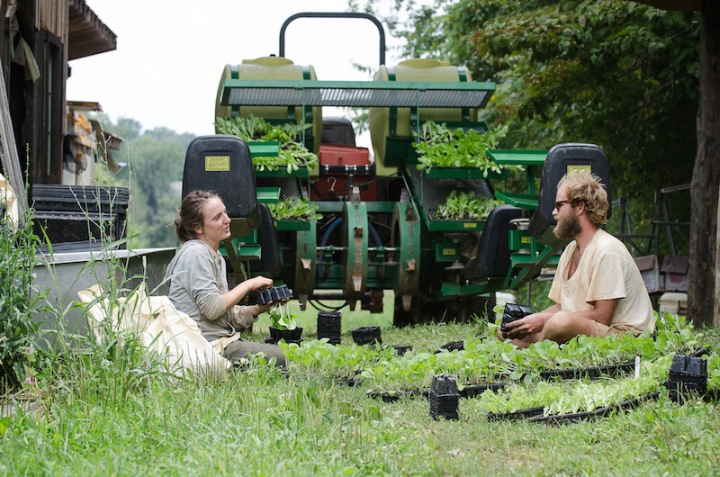Photos by Rich Orris. Instagram images by Travis Moore.
Follow a gravel road through the heart of Leicester, traverse a water-filled ditch, and you’ll find Western North Carolina’s future farmers hard at work. At Gaining Ground Farm, four aspiring growers cradle seedlings, scooping out precious lettuce and bok choy plants from cell containers to prepare them for their journey from greenhouse to field.
Aaron and Anne Grier, 34 and 39 years old, respectively, oversee the operation. They’re a new breed of growers who share their expertise with aspiring farmers, some in their early 20s and just entering the field. “That energy and young idealism is inspiring,” Aaron says, as he describes the “intense” experience of interning on a family farm.
Gaining Ground’s interns and owners — and their counterparts throughout Western North Carolina — are creating our region’s agricultural landscape, one handful of dirt at a time.
The graying of family farms
Nationally, the average age of principal farm operators is 57 years old. That number has increased each census cycle since the late 1970s, and the most recent data identifies the fastest growing demographic among farmers as even older — 65 or more.
In WNC, the average age hovers at 57, although Charlie Jackson, executive director of the Appalachian Sustainable Agriculture Project, notes that this might change when the next census takes into account the 2004 tobacco buyouts that encouraged farmers to shift to more sustainable crops.
The census data can be misleading at first glance, he explains. “As a rule, farmers tend to kind of not retire, unlike in other professions. You’ll frequently find 78-year-old people who are continuing to farm, which kind of skews those numbers,” Jackson says.
Still, the economic and physical demands of farming can force older growers to end their careers before they’re ready to hang up the pitchfork. Joe Evans, a 27-year-old who operates Paper Crane Farm in Mars Hill with his partner, Tara Jensen, has seen this firsthand. He knows older farmers who are choosing between their personal health and their livestock. “Seeing that so close to home is very saddening,” Evans says.
However, when older growers do retire, they leave a gap in the farming landscape that greenhorns are eager to fill. “The reality is that in other places in the country, they’re really struggling to get new farmers in. Here we’re not,” Jackson says. “There are people who are eager to farm, but they’re running into other challenges, like access to land.”
The cost of a plot
One of the major difficulties for beginning farmers is finding somewhere to grow. Many young people, whether they’re buying a farm or a house in the suburbs, face hurdles when they approach a bank for the first time. Establishing credit is a long process, but buying farmland brings its own difficulties.
Much of WNC’s land is priced for what could be built on it rather than what it could grow. Jackson says that many of our region’s plots, especially closer to the Asheville area, are evaluated for their development appeal and potential for second homes instead of the capacity for growing fruits and vegetables. This leaves young farmers in a financial bind, even when they do find land that appeals to them.
“I just don’t see myself being able to buy land,” Evans says. “What farmland there is, [it’s] is very, very expensive. If you’re not independently wealthy or not inheriting family land, how do you come about finding a farm?”
Evans hopes to continue farming a plot of land in Mars Hill owned by Bob Lackey and Doris Gordon, a couple from Atlanta who are working to preserve WNC’s farmland. “I hope to be here next year, but as a sharecropper, I just take it season by season,” Evans says.
Jackson believes that keeping farmers like Evans in the business is essential to the future of our food economy. “There’s an important public interest in us trying to figure out the way for farmers to get on land because it brings so many values to our community.” Jackson says.

New techniques for modern farmers
Anne from Gaining Ground grew up in a farming family. Her parents were beef cattle farmers until the mid-1970s, when the economics of producing hundreds of acres of commodity corn and 200 heads of cattle forced them to shut down their operation.
These financial hardships didn’t dampen Anne’s passion for living off the earth. “I always wanted to be a farmer,” she explains. Anne was about 5 years old when her family stopped farming, so she recalls the beauty of the work and land more than the economic troubles. “All I could remember was the great romantic stuff about it,” she says. “I didn’t know anything about the work, necessarily. I just wanted to do it.”
Anne’s approach to family farming is very different from her parents’ large-scale business. Gaining Ground grows a wide range of vegetables, from cabbage to sweet potatoes. The rows are tidy, but varied, with a little bit of everything planted side by side.
“Diversity is my crop insurance,” she says, while walking through a field of Southern staples like okra and black-eyed peas. During this particularly rainy and challenging growing season, having a variety of vegetables has meant there’s almost always something to take to market and sell to restaurants. Anne says she’d rather have 10 acres of 100 different crops than cattle or corn as far as the eye can see.

Green Hill Urban Farm in West Asheville takes a similar approach. Operator Mike Fortune plants raspberry bushes near pole beans, and apricot tree branches sway overhead. In a tank at the front of the property, a fish named Crackers stands guard. This bright orange koi does more than greet visitors; like nearly everything on the property, Crackers serves a purpose.
Fortune uses aquaponics to fertilize his fig trees. The lone koi’s waste feeds the fig trees, which in turn provide a bounty of fruit every year. This small-scale, sustainable approach to farming uses aquatic animals to fertilize plants in a hydroponic loop. Like Fortune, many young growers combine new inventions with traditional methods to promote a diverse farm for the 21st century.
And many go even further.
Tweets from the tractor
When Evans wants to let people know about a new crop of onions or purple potatoes, he takes out his iPhone and snaps a picture. Instagram, Twitter and Facebook give him a chance to share the realities of farming with customers who might not otherwise know about the rigors and joys of growing professionally.
“When you put up a picture of this moment of what you’re working on or what you’re doing, it communicates to this deeper level,” Evans says. He is part of a community of farmers — from Maine to Tennessee to Big Sandy Mush, N.C. — who spread the gospel of farming through social media.
Burgeoning farms often use social media as a way to create ties with potential customers, especially when the farm doesn’t have a budget for advertising. Travis Moore, who operates near Brevard with his partner, Jess Jordan, says that simple gestures like photos of eggs from the chicken coop give the public a glimpse into farm life and builds relationships with future customers.
“When we do finally get to that point where we do have a farm store and we’re consistently selling stuff, people that we continually reached out to — and [who] have also turned around and reached out to us — are going to be the ones who will be loyal customers,” Moore says.
Each day, he ventures onto his farm, carrying his smartphone in a waterproof, dirt-proof case. “The times when you’re in the pen working with the pigs and you’re doing something and then all of sudden they do something — it’s just that split second you have to whip out your phone and take a picture,” he says. Moore believes that great photos happen when farmers are in the thick of it, not necessarily when they take a camera outside to hunt for pictures.

Keeping up with a farm and social media doesn’t feel so natural to everyone. “We kind of see [social media] as a necessary evil. It’s not something we enjoy,” Aaron says. “We’re trying to get good at growing food, and marketing ourselves is definitely hard,” he says.
One way to improve these skills is for farmers to take social-media classes specifically for them. Last year, the Carolina Farm Stewardship Association, in partnership with several other organizations, presented a series of workshops on social media. Farmers, both young and old, spent the day learning the principles of sharing their experiences online. Participants left with fully functioning Facebook and Twitter pages, giving them an immediate opportunity to share their farm lives with the public.
“People are curious,” says instructor Grace Kanoy of GeoCore Films. “Maybe you reveal a bit of behind the scenes. Maybe show how you run your farm, because people are looking for transparency.”
One of the major barriers for growers who want to improve their social-media presence is time. For many farmers, the immediate needs of crops and livestock come first. “They know that they need to put the time in, but things happen on the farm that take priority,” Kanoy says. “Animals don’t wait; when it’s time to harvest, that doesn’t wait. But the Internet seems to be able to wait.”
Social media may not come naturally to every young farmer, but such outlets as Facebook and Instagram do provide a tangible tie between growers and the public — something that’s hard to come by when farmers spend morning, noon and night with their hands in the soil.
Making connections
Most Saturday afternoons, you’ll find young farmers gathered around the table at an Asheville restaurant to share a beer, a sandwich and their experiences. For the past two years, Evans has joined fellow City Market tailgate vendors for a “weekly communion.” A lot of his friends are farmers or bakers at the market and they frequently come together to swap stories. “There’s definitely a community of close-knit folks,” he says.
Tailgate markets are a natural place for farmers to get together, especially those who live farther out of Asheville. “There’s so much camaraderie just at market,” Anne says. She doesn’t get many opportunities to socialize with other farmers during growing season, but that doesn’t stop them from calling on each other when times get tough. “We all call each other with questions,” Anne says. “A bunch of our tomato plants died this spring, and farmer friends who had extra gave them to us. That kind of stuff happens all the time.”
“I know lots of other younger farmers who are doing just what I’m doing: CSAs and growing vegetables,” says Fortune. He regularly hosts Crop Mobs, a loose-knit collection of farm-enthusiasts who descend upon a farm to perform free labor, from pulling weeds to harvesting. This national movement has gained momentum locally and brings the farming community together. “It’s cool to see a really nice group of young people that are really chomping at the bit to grow food,” Fortune says. “There’s more and more of us up here in Asheville every day.”
Looking toward the future
When Anne and Aaron take a break from work at Gaining Ground, they usually have 3-year-old Addiebelle and 1-year-old Cyril wriggling in their laps or climbing up their legs.
The Grier family hopes that their children will one day take over the operation. But before they can adapt to the challenges of modern farming, there must be a family farm to maintain. This goal is fostered by a community of local growers who value multigenerational farming as a driving force in the food economy.
“Now the next generation is coming back, and they’re seeing new opportunities and seeing ways that they can be innovative and kind of break out of the mold of their heritage and they way they’ve always done things,” Jackson says.

Anne and Aaron want to inspire their children to continue their family’s farm, if that’s where their passion lies. “I hope that we can have a business here that we can pass on to them, if they want it,” Aaron says. Their family’s connection to several independent, farm-to-table restaurants and their presence at local tailgate markets make this a true possibility.
“I think we’re a new generation, but something else will come along too. I feel like everything changes,” says Aaron as he thinks about our region’s farming potential. With a little luck and a lot of hard work, the Grier’s round-faced, curly-locked kids could be the future of farming in WNC.




Before you comment
The comments section is here to provide a platform for civil dialogue on the issues we face together as a local community. Xpress is committed to offering this platform for all voices, but when the tone of the discussion gets nasty or strays off topic, we believe many people choose not to participate. Xpress editors are determined to moderate comments to ensure a constructive interchange is maintained. All comments judged not to be in keeping with the spirit of civil discourse will be removed and repeat violators will be banned. See here for our terms of service. Thank you for being part of this effort to promote respectful discussion.